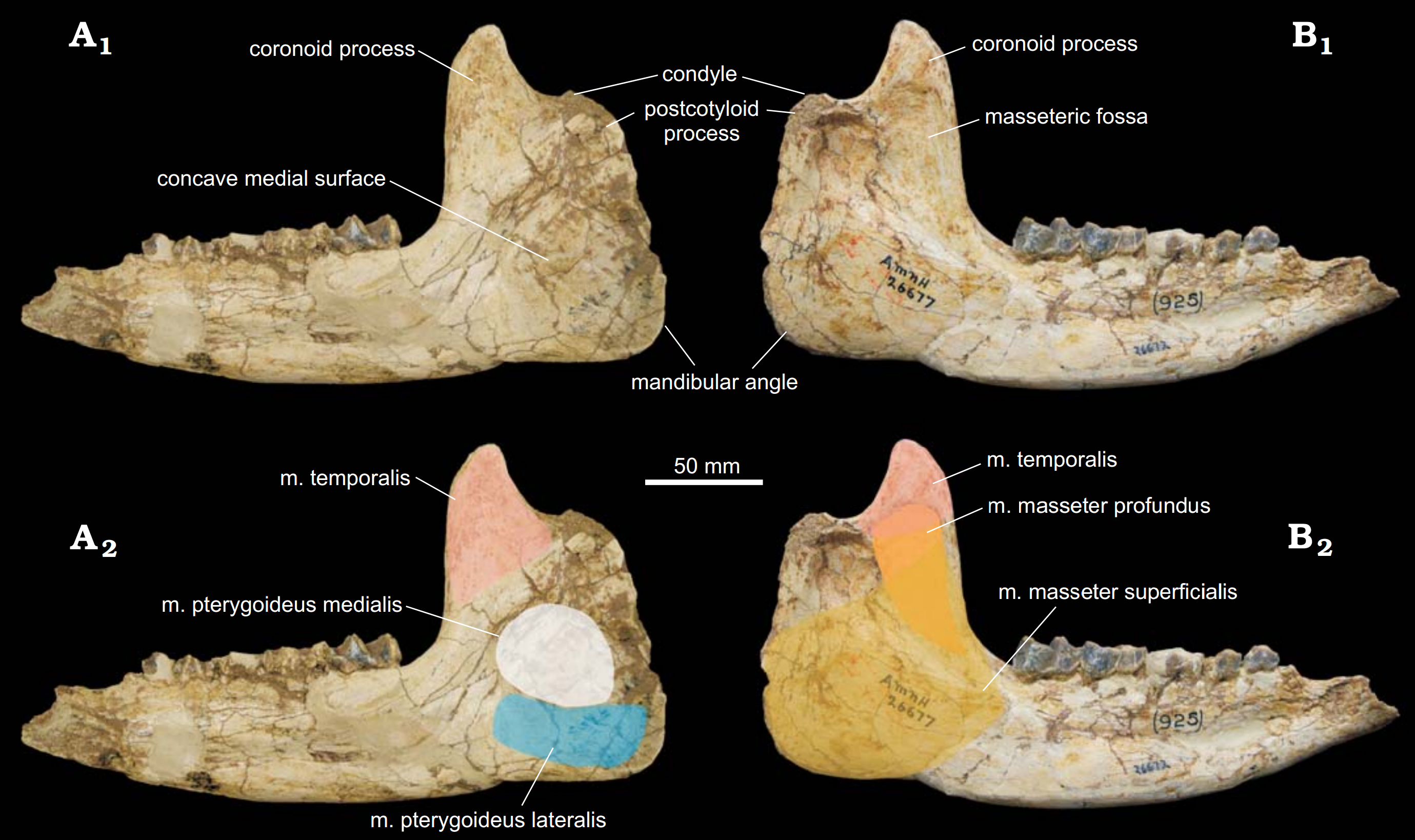|
Forstercooperia
''Forstercooperia'' is an extinct genus of forstercooperiine paraceratheriid rhinoceros from the Middle Eocene of Asia. Description ''Forstercooperia'' is known from a vast amount of cranial material, although only some scant postcranial remains. The average size of the genus is about equal with a large dog, even though later genera like ''Juxia'' and ''Paraceratherium'' reached sizes of a cow and even much larger. Like primitive rhinocerotoids, ''Forstercooperia'' possesses blunt ends on the tips of its nasals, above the nasal incision. Unlike all modern rhinoceroses, the nasals of ''Forstercooperia'', as well as many related genera, lack rugosities, which suggests that they lacked any form of horn. The nasal incision extends fairly far into the upper jaw, ending just posterior to the canine. ''Forstercooperia'' possesses a small post-insicor diastema, not as large as its descendants, and similar in size to that of ''Hyracodon''. Taxonomy ''Forstercooperia'' is considered to be ... [...More Info...] [...Related Items...] OR: [Wikipedia] [Google] [Baidu] |
Pappaceras
''Pappaceras'' is an extinct genus of rhinoceros from the Early Eocene of Asia belonging to Paraceratheriidae. Taxonomy In 1963, material including a partial skull containing cheek teeth was unearthed in Late Eocene deposits of Mongolia. These remains were identified as from a true rhinoceros by Wood, who found them an important discovery with the scant amount of previous cranial material of early rhinocerotids available. On July 25, the same year, a paper was published by Wood concerning the taxonomy and osteology of these remains, in which he named them a new genus and species (or binomial) as well as re-ranking a previously named family as a subfamily containing the new taxon. The binomial created was ''Pappaceras confluens'', classified as a close relative of ''Forstercooperia'' within Forstercooperiinae (before Forstercooperiidae, named in 1940 by Kretzoi). Wood noted that the generic name is derived from the Latin word ''πaππos'', "grandfather", and the Greek words ''alp ... [...More Info...] [...Related Items...] OR: [Wikipedia] [Google] [Baidu] |
Uintaceras
''Uintaceras'' is an extinct genus of medium-sized rhinoceros that lived in North America (Wyoming and Utah) during the Middle Eocene, with only the type species ''U. radinskyi'', named in 1997, currently contained within the genus.L. T. Holbrook and S. G. Lucas. 1997. A New Genus of Rhinocerotoid from the Eocene of Utah and the Status of North American "''Forstercooperia''". ''Journal of Vertebrate Paleontology'' 17(2):384-396 ''Uintaceras'' is the oldest and most primitive species of the Rhinocerotidae known to date, although it may have belonged to its own, currently unknown, separate family. The dubious species ''Forstercooperia'' (''Hyrachyus'') ''grandis'' (Radinsky, 1967; Peterson, 1919)Peterson, O.A. (1919). "Report upon the Material Discovered in the Upper Eocene of the Uinta Basin by Earl Douglas in the years 1908-1909, and by 0. A. Peterson in 1912". ''Annals of the Carnegie Museum''. pp. 40–168. is also possibly the same animal as ''Uintaceras'', although the Asian m ... [...More Info...] [...Related Items...] OR: [Wikipedia] [Google] [Baidu] |
Juxia
''Juxia'' (from , usually refers to indricotheres) is an extinct genus of indricothere, a group of herbivorous mammals that are part of the odd-toed ungulate family tree of rhinoceros and tapirs. The type species is ''Juxia sharamurenensis'', named by Zhou Mingzhen and in 1964. ''Juxia'' was around the size of a horse. It lived in Asia during the upper Eocene The Eocene ( ) Epoch is a geological epoch that lasted from about 56 to 33.9 million years ago (mya). It is the second epoch of the Paleogene Period in the modern Cenozoic Era. The name ''Eocene'' comes from the Ancient Greek (''ēṓs'', " .... As an early indricothere, ''Juxia'' had a relatively light body, held by elongated long legs and small skull firmly attached to a relatively long neck. Based on its triangular like teeth and sharp protruding incisors, ''Juxia'' was probably a strict browser, feeding on ferns and leaves on branches where most herbivorous mammals couldn't reach. In terms of habitat, ''Juxi ... [...More Info...] [...Related Items...] OR: [Wikipedia] [Google] [Baidu] |
Rhinocerotoidea
Rhinocerotoidea is a superfamily consisting of three family groups of odd-toed ungulates, three of which, the Amynodontidae, Hyracodontidae, and Paraceratheriidae, are extinct. The only extant family group is the Rhinocerotidae (true rhinoceroses), which survives as five living species. The extinct members of this superfamily are often called "rhinoceroses" alongside members of the family Rhinocerotidae, though they include genera, such as ''Paraceratherium'', which do not closely resemble modern rhinoceroses. Taxonomy The cladogram below follows a phylogenetic analysis In biology, phylogenetics (; from Greek φυλή/ φῦλον [] "tribe, clan, race", and wikt:γενετικός, γενετικός [] "origin, source, birth") is the study of the evolutionary history and relationships among or within groups o ... by Bai ''et al.'' (2020): References {{Taxonbar, from=Q15487229 Odd-toed ungulates Mammal superfamilies Taxa named by John Edward Gray ... [...More Info...] [...Related Items...] OR: [Wikipedia] [Google] [Baidu] |
Indricotheriinae
Paraceratheriidae is an extinct family of long-limbed, hornless rhinocerotoids, commonly known as paraceratheres or indricotheres, that originated in the Eocene epoch and lived until the early Miocene. The first paraceratheres were only about the size of large dogs, growing progressively larger in the late Eocene and Oligocene. They were most common in the rainforest floodplain region which is now Kazakhstan, India, and southwest China, and lived further inland throughout northern and central Asia as well. The paraceratheres reached the peak of their evolution from the middle Oligocene to the early Miocene, where they became very large, herbivorous mammals. Most genera were about the size of modern draft horses and the extinct giant horse ''Equus giganteus'', with some growing significantly larger. The largest genus was ''Paraceratherium'', which was more than twice as heavy as a bull African elephant, and was one of the largest land mammals that ever lived. However, they remain ... [...More Info...] [...Related Items...] OR: [Wikipedia] [Google] [Baidu] |
Irdin Manha Formation
The Irdin Manha Formation is a geological formation from the Eocene located in Inner Mongolia, China, a few kilometres south of the Mongolian border Description U.S. paleontologists Henry Fairfield Osborn and Roy C. Andrews discovered two premolars on the site in 1923, and assigned the specimen to the new genus '' Eudinoceras'' because he believed it to be related to "'' Dinoceras''" (now known as ''Uintatherium''). Within a decade, however, as more complete specimens were recovered, the animal was identified as a Mongolian relative to the North American pantodont ''Coryphodon''. The expedition also lead to the discovery of the only known skull of ''Andrewsarchus''. See also * List of fossil sites This list of fossil sites is a worldwide list of localities known well for the presence of fossils. Some entries in this list are notable for a single, unique find, while others are notable for the large number of fossils found there. Many of t ... References Bibliogr ... [...More Info...] [...Related Items...] OR: [Wikipedia] [Google] [Baidu] |
Accession Number (library Science)
In libraries, art galleries, museums and archives, an accession number is a unique identifier assigned to, and achieving initial control of, each acquisition. Assignment of accession numbers typically occurs at the point of accessioning or cataloging. The term is something of a misnomer, because the form accession numbers take is often alpha-numeric.Witt, B.S., Whittfield, J.C., Stepansky, A.J. (2012) ''Pastperfect software for museum collections: Version 5 users guide.'' Retrieved from http://museumsoftware.com/v5userguide.html If an item is removed from the collection, its number is usually not reused for new items. In Libraries In libraries, this numbering system is usually in addition to the library classification number (or alphanumeric code) and to the ISBN or International Standard Book Number assigned by publishers. In Botany Accession numbers are also used in botany, by institutions with living collections like arboreta, botanic gardens, etc., to identify plants ... [...More Info...] [...Related Items...] OR: [Wikipedia] [Google] [Baidu] |
American Museum Of Natural History
The American Museum of Natural History (abbreviated as AMNH) is a natural history museum on the Upper West Side of Manhattan in New York City. In Theodore Roosevelt Park, across the street from Central Park, the museum complex comprises 26 interconnected buildings housing 45 permanent exhibition halls, in addition to a planetarium and a library. The museum collections contain over 34 million specimens of plants, animals, fossils, minerals, rocks, meteorites, human remains, and human cultural artifacts, as well as specialized collections for frozen tissue and genomic and astrophysical data, of which only a small fraction can be displayed at any given time. The museum occupies more than . AMNH has a full-time scientific staff of 225, sponsors over 120 special field expeditions each year, and averages about five million visits annually. The AMNH is a private 501(c)(3) organization. Its mission statement is: "To discover, interpret, and disseminate—through scientific research ... [...More Info...] [...Related Items...] OR: [Wikipedia] [Google] [Baidu] |
George Olsen
George Edward Olsen Sr. (March 18, 1893 - March 18, 1971) was an American bandleader. Born in Portland, Oregon, Olsen played the drums and attended the University of Michigan, where he was drum major. There he formed his band, George Olsen and his Music, which continued in the Portland area. The group's debut hotel engagement came at the Multnomah Hotel in Portland. He then made the cross-county transition to Broadway, appearing in '' Kid Boots'' (1923), the '' Ziegfeld Follies of 1924'', ''Ziegfeld Follies of 1925'', and '' Good News'' (1927). George Olsen and his Music were prolific Victor recording artists and their records are among the most numerous found by record collectors today, testifying to their original popularity. He and his orchestra were in Eddie Cantor's 1928 Broadway hit '' Whoopee!'', and in the 1930 movie version. In the ''Follies'' George met a singer, Ethel Shutta, who sings and dances memorably in '' Whoopee!'', and they married, appearing together i ... [...More Info...] [...Related Items...] OR: [Wikipedia] [Google] [Baidu] |
Horace Elmer Wood II
Quintus Horatius Flaccus (; 8 December 65 – 27 November 8 BC), known in the English-speaking world as Horace (), was the leading Roman lyric poet during the time of Augustus (also known as Octavian). The rhetorician Quintilian regarded his ''Odes'' as just about the only Latin lyrics worth reading: "He can be lofty sometimes, yet he is also full of charm and grace, versatile in his figures, and felicitously daring in his choice of words."Quintilian 10.1.96. The only other lyrical poet Quintilian thought comparable with Horace was the now obscure poet/metrical theorist, Caesius Bassus (R. Tarrant, ''Ancient Receptions of Horace'', 280) Horace also crafted elegant hexameter verses (''Satires'' and ''Epistles'') and caustic iambic poetry ('' Epodes''). The hexameters are amusing yet serious works, friendly in tone, leading the ancient satirist Persius to comment: "as his friend laughs, Horace slyly puts his finger on his every fault; once let in, he plays about the heartstrings" ... [...More Info...] [...Related Items...] OR: [Wikipedia] [Google] [Baidu] |
Binomial Nomenclature
In taxonomy, binomial nomenclature ("two-term naming system"), also called nomenclature ("two-name naming system") or binary nomenclature, is a formal system of naming species of living things by giving each a name composed of two parts, both of which use Latin grammatical forms, although they can be based on words from other languages. Such a name is called a binomial name (which may be shortened to just "binomial"), a binomen, name or a scientific name; more informally it is also historically called a Latin name. The first part of the name – the '' generic name'' – identifies the genus to which the species belongs, whereas the second part – the specific name or specific epithet – distinguishes the species within the genus. For example, modern humans belong to the genus '' Homo'' and within this genus to the species '' Homo sapiens''. '' Tyrannosaurus rex'' is likely the most widely known binomial. The ''formal'' introduction of this system of naming species is ... [...More Info...] [...Related Items...] OR: [Wikipedia] [Google] [Baidu] |
Rhinoceros
A rhinoceros (; ; ), commonly abbreviated to rhino, is a member of any of the five extant taxon, extant species (or numerous extinct species) of odd-toed ungulates in the family (biology), family Rhinocerotidae. (It can also refer to a member of any of the extinct species of the superfamily Rhinocerotoidea.) Two of the extant species are native to Africa, and three to South Asia, South and Southeast Asia. Rhinoceroses are some of the largest remaining megafauna: all weigh at least one tonne in adulthood. They have a herbivore, herbivorous diet, small brains (400–600 g) for mammals of their size, one or two horns, and a thick (1.5–5 cm), protective skin formed from layers of collagen positioned in a crystal structure, lattice structure. They generally eat leafy material, although their ability to ferment food in their colon (anatomy), hindgut allows them to subsist on more fibrous plant matter when necessary. Unlike other perissodactyls, the two African species of ... [...More Info...] [...Related Items...] OR: [Wikipedia] [Google] [Baidu] |








